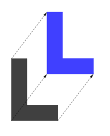Similarity (geometry)
In terms of geometry , two figures are exactly similar to one another if they can be converted into one another by means of a similarity mapping (this mapping is also often referred to as similarity ). This means that there is a geometric mapping that can be composed of centric stretching and congruence mapping (i.e. shifts , rotations , reflections ) and that maps one figure onto the other. Similarity extends the congruence ( congruence ) of figures by the possibility of stretching.
In the table are the first three congruence maps. Note that a reflection reverses orientations. Only centric stretches change lengths.
properties
Angle and route relationships match in similar figures; thus all circles and all regular polygons with the same number of corners, such as equilateral triangles and squares , are similar to one another.
It is true that congruent figures are always similar. The reverse is wrong, however: Similar figures are not necessarily congruent, as they can be of different sizes.
(The tilde ) is used as a mathematical symbol for geometric similarity , for example: means that the triangles and are similar. If, on the other hand, you want to express congruence, or (a “mixture” with the equal sign ) can be used instead.
Similarity in triangles
Triangles play a central role here, as many figures can be traced back to them. The following applies:
Two triangles are similar to each other if
- they coincide in two (and thus in all three) angles; or
- they match in all proportions of the corresponding sides; or
- they coincide at one angle and in proportion to the adjacent sides; or
- they match in the ratio of two sides and in the opposite angle of the larger side.
These sentences are called similarity sentences .
Ray theorems
The ray theorems make important statements about the proportions of the triangle sides of certain similar triangles.
Similar conic sections
- Two non-degenerate conic sections (ellipse, hyperbola, parabola) are similar if they have the same eccentricity.
The similarity of all parabolas (their eccentricity is 1) is shown in the article Parabolas .
An ellipse / hyperbola with semi-axes has the eccentricity. Stretching by the factor at the center point does not change the eccentricity.
Self-similarity of logarithmic spirals
The logarithmic spiral can be understood on the one hand as a picture of the spiral under the stretching at the zero point with the factor , but also as a picture of the rotation around the angle .
A curve whose images are congruent to itself under centric stretching is called self-similar . So:
- The spiral is self-similar.
Pictured: the spirals for can also be obtained by rotating the red spiral around .
Similarity in fractal geometry
Scale-invariant similarity in broken, “fractal” dimensions is the subject of fractal geometry .
The similarity is the result of the recursion of nonlinear algorithms. A well-known example is the Mandelbrot set , the borderline of which is similar at every point to the adjacent sections in all orders of magnitude.


























